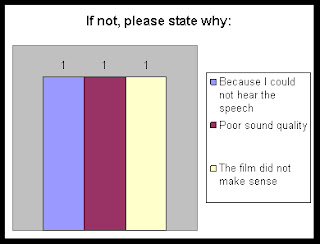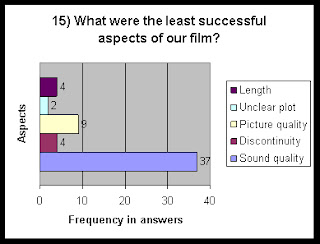Emily's blog
Wednesday, 11 May 2011
Wednesday, 27 April 2011
Director's Commentary
Here is a run-through of our final product with a director's commentary over the top, explaining some of the difficulties and the processes we encountered in order to arrive at our finished film.
Tuesday, 11 January 2011
Subtask Review Drafts
Sub task 2 - draft 1
This is the first of three drafts I am going to make for my magazine review in the format of a double page spread. I am doing this so I can create visual examples of different layouts I might use for my product. All the drafts are based on modern magazine reviews of short films.
Subtask poster - layout
After consulting with Emily and looking at photographs we had taken I felt that this layout fit best with the genre. At first I wanted to go with draft three as I thought that an image of the couple would be most effective, however Emily and I both agreed that the image of Rita was the strongest. This is because of her expression, the way she is looking straight down the lens of the camera and the use of the cigarette as a prop looked very conventional and striking. Her body language was also strong and would look good on full size poster, and as our female protagonist in the middle of a love triangle I felt that her role was crucial as the centre.
Subtask drafts
Sub task 1 - draft 1
This is the first of three drafts I am going to make for my poster. I am doing this so I can create visual examples of different layouts I might use for my poster. All the drafts are based on 1940s film noir posters where the conventions are to have several images placed on the poster. To comply with the conventions of short film posters I have also included text on the poster giving information about the directors and producers etc.
Choosing our fonts for our three products
After looking over some conventional forties film noir posters I found that the font used for the title were either a) very simple and bold or b) very cartoonish. For example:
I thought that the simple bold fonts would work the best with our film as its a short film as well as being in the style of film noir. I looked on dafont and here our the choices that I narrowed it down to:
After getting some opinions from my peers and I same to the decision of using this font as it was the most visually appealing and it fitted within the genre the most effectively.

I thought that the simple bold fonts would work the best with our film as its a short film as well as being in the style of film noir. I looked on dafont and here our the choices that I narrowed it down to:
After getting some opinions from my peers and I same to the decision of using this font as it was the most visually appealing and it fitted within the genre the most effectively.

Photoshoot
After shooting the film we set up a photo-shoot with our three actors to get photographs to use in our two secondary products, the poster and magazine review. We used a white screen and two lights to get the highest quality images possible. To give us the biggest selection possible we decided to take full length shots of each actor, head shots of each actor and then full length shots of the main two characters (Rita and Jim) together.
Friday, 7 January 2011
Evaluation - part 4
My use of media technologies in this project has ranged from using digital cameras to complicated video editing software to troubleshoot a wide variety of technical problems and I have learnt much about editing software, slide-show making software, animation software and equipment like the larger DV videocameras and use of hard lighting with the lamps.
During my research and production, I used the website www.polldaddy.com to gain feedback when canvassing our film concept and have used www.blogger.com to post the various stages of our project. I used Slideshare to illustrate various elements of production and create an animatic storyboard to preview how we intended our film to look, and Youtube to broadcast our final product to gain audience feedback, and Facebook to advertise this to my peers, aiding the evaluation process.
From relearning how best to use a digital stills camera for the type of high key shots we needed for the film poster to learning setting up the stands, poles and white sheet backdrop to reflect light and easily edit the images, learning to use the high-wattage photography lamps to control light for various effects was one of the most useful skills I learnt with technology. Using the Photoshop to create our sub-tasks was an enjoyable and fruitful process for us, as we had used the software before and using layers and the many effects and adjustment possibilities Photoshop offers,
Using the videocameras was an enlightening process as we discovered which were the best settings and effects to capture the type of look we needed on our film, and editing three hours worth of footage and retakes into a short film was where I became proficient in using Final Cut Pro. Initially we had to upload the footage using iMovie as the Final Cut software was not functioning correctly. Final Cut did have its many limitations and problematic obstacles but we overcame these by using iMove to resolve these then reimporting back into Final Cut. Many problems we came across like difficulty in hearing the sound and needing to disguise the daylight through the windows were resolved using Final Cut's blue-green eliminator, as well as dubbing the audio from other takes over a few of Jim's lines as the best take visually was ruined with too much restaurant ambient noise interfering with the dialogue. What seemed like unfixable issues we learnt to rectify with editing software, however in importing then reimporting and converting the file between the two softwares we did compromise some of the quality noticeably.
Our use of garageband in recording the narrative voice-over of our film was crucial as the poor quality microphone picked up too much breath, "p's" and "s's", and garageband had certain effects and programs we could use to disguise flaws and improve the quality to aid the overall success of our film. Finally, our use of the in built webcams on the mac computers we were using were especially useful in gathering multimedia footage of audience feedback.
The issues I had with blogger when posting the project's process were very frustrating as it was difficult to see the progression of the task chronologically, as it would display the posts backwards from the most recent and divide them into monthly sections. Also its very basic limitations on how we could display our work, i.e image size and it's complicated and way of formatting the layout made me find I spent more time trying to get the blog look coherent and presentable than I would have liked, and prefer iWeb or even Livejournal.com to blogger. However, it was accessible and convenient to use at home, so we learnt to use it as effectively as possible and put up with any issues.
During my research and production, I used the website www.polldaddy.com to gain feedback when canvassing our film concept and have used www.blogger.com to post the various stages of our project. I used Slideshare to illustrate various elements of production and create an animatic storyboard to preview how we intended our film to look, and Youtube to broadcast our final product to gain audience feedback, and Facebook to advertise this to my peers, aiding the evaluation process.
From relearning how best to use a digital stills camera for the type of high key shots we needed for the film poster to learning setting up the stands, poles and white sheet backdrop to reflect light and easily edit the images, learning to use the high-wattage photography lamps to control light for various effects was one of the most useful skills I learnt with technology. Using the Photoshop to create our sub-tasks was an enjoyable and fruitful process for us, as we had used the software before and using layers and the many effects and adjustment possibilities Photoshop offers,
Using the videocameras was an enlightening process as we discovered which were the best settings and effects to capture the type of look we needed on our film, and editing three hours worth of footage and retakes into a short film was where I became proficient in using Final Cut Pro. Initially we had to upload the footage using iMovie as the Final Cut software was not functioning correctly. Final Cut did have its many limitations and problematic obstacles but we overcame these by using iMove to resolve these then reimporting back into Final Cut. Many problems we came across like difficulty in hearing the sound and needing to disguise the daylight through the windows were resolved using Final Cut's blue-green eliminator, as well as dubbing the audio from other takes over a few of Jim's lines as the best take visually was ruined with too much restaurant ambient noise interfering with the dialogue. What seemed like unfixable issues we learnt to rectify with editing software, however in importing then reimporting and converting the file between the two softwares we did compromise some of the quality noticeably.
Our use of garageband in recording the narrative voice-over of our film was crucial as the poor quality microphone picked up too much breath, "p's" and "s's", and garageband had certain effects and programs we could use to disguise flaws and improve the quality to aid the overall success of our film. Finally, our use of the in built webcams on the mac computers we were using were especially useful in gathering multimedia footage of audience feedback.
The issues I had with blogger when posting the project's process were very frustrating as it was difficult to see the progression of the task chronologically, as it would display the posts backwards from the most recent and divide them into monthly sections. Also its very basic limitations on how we could display our work, i.e image size and it's complicated and way of formatting the layout made me find I spent more time trying to get the blog look coherent and presentable than I would have liked, and prefer iWeb or even Livejournal.com to blogger. However, it was accessible and convenient to use at home, so we learnt to use it as effectively as possible and put up with any issues.
Subscribe to:
Comments (Atom)




















































